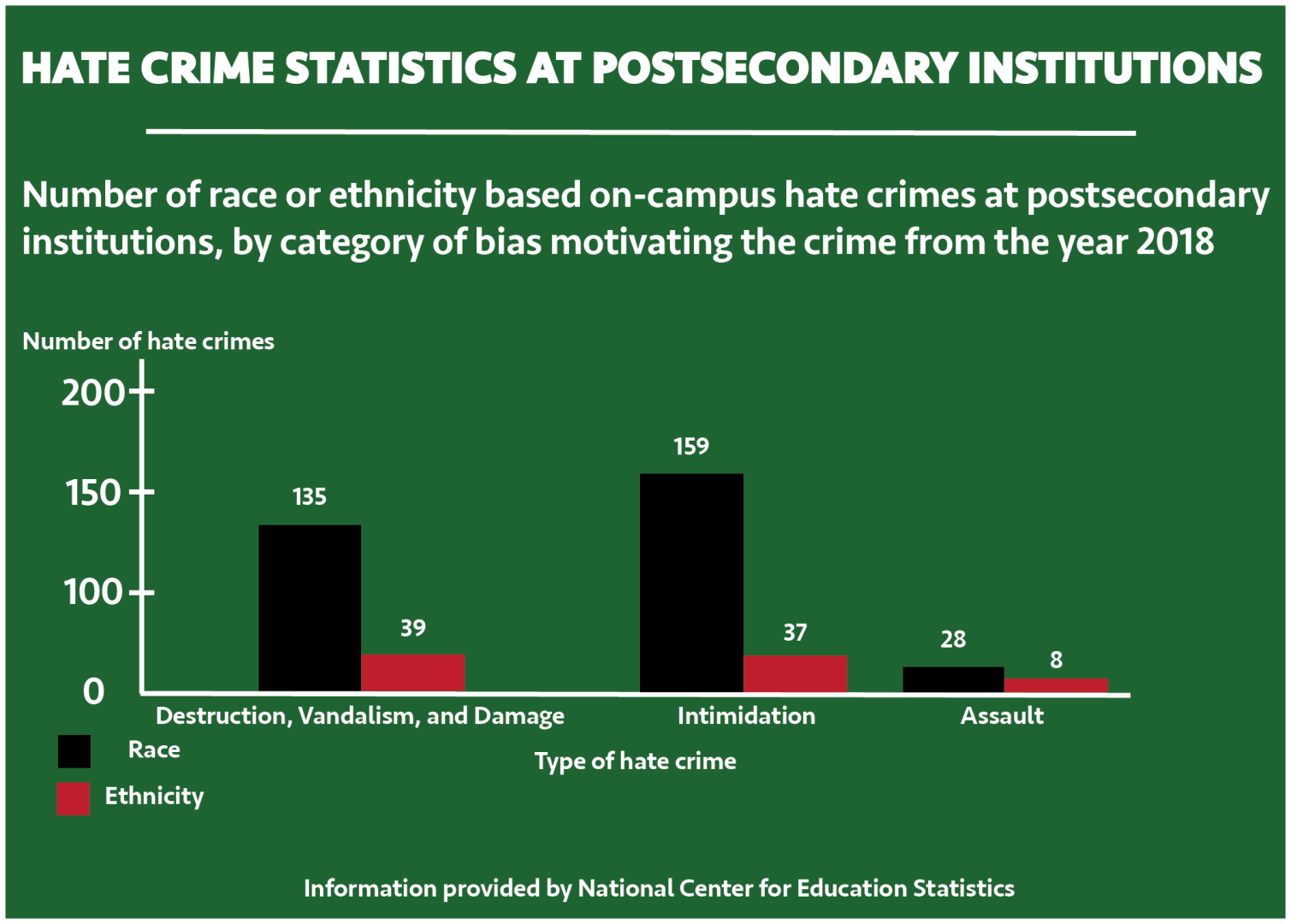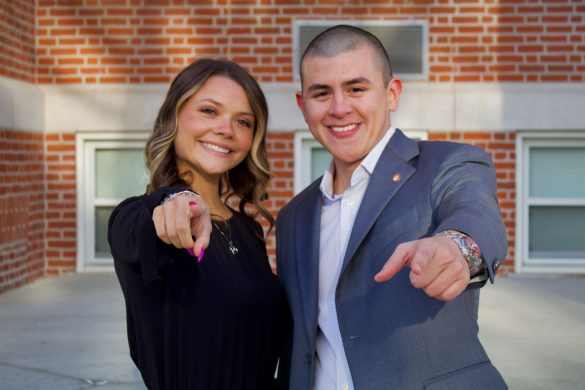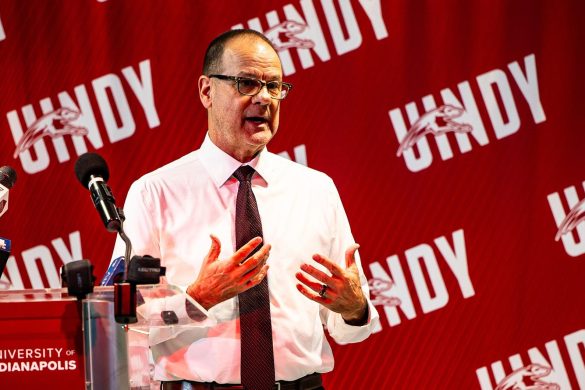Editor’s note: This story contains references to a racial slur. The AP Style Manual states to only include the “N-word” when it is crucial to the story or understanding of a news event. Staff felt it was important to include it here to allow students to recount their experiences as victims of racism and hate speech.
While entering Warren Hall on Nov. 14, four men walked past freshman communication major Amira Donahue as she opened the door for them. She said that as they walked away, she heard them yell a racial slur. That night, Donahue said she decided to create a post on the UIndy app that said, “Can we talk about the casual racism at UIndy?”
“I was just walking in. I heard one of them yell, ‘Is that a N-word?’…” Donahue said. “At first, I thought I was hearing stuff. I just kind of continued about my day. And they actually showed me the CCTV footage, and you can see me with a handful of stuff open the door for them. And then all of them walk through and just leave me struggling with the door with my hands full. And then we keep walking. And then when they get to the boy’s side of the door, they yelled the N-word and then run up the stairs.”
Immediately after the incident occurred, Donahue said she went up to the resident assistant’s desk and asked if the person would do anything about it, but believed the person working did not hear exactly what was said. She said she had expected more help, and because of this, she posted about her experience on the UIndy App. Afterward, she received emails about the incident from the Residence Director and the Office of Inclusion and Equity, Donahue said.
“They’re currently investigating what’s been happening, and I feel like they’ve been doing a good job with the investigation,” Donahue said. “I don’t have anything really to say about that. I feel like they’re handling everything accordingly. I’m not upset with the school, per se, but definitely, like the culture and just the fact that it even happened was very upsetting to me.”
The UIndy Student Handbook, under Standard IV, states that students must uphold the university’s mission by being responsible citizens. According to Senior Associate Dean of Students and Title IX Coordinator Jessica Ward, hate speech is covered under Section F of this standard, which states, “The University will consider as an aggravating factor in determining sanctions, any violation of law or of this code in which the accused student intentionally selected the person or target of the violation based on gender, race, religion, color, disability, sexual orientation, gender identity, national origin, ancestry, age, marital status, veteran’s status (as protected by law), or other basis of discrimination precluded by federal and state statues.”
An email from Vice President for Student and Campus Affairs and Dean of Students Kory Vitangeli that was sent out to students on Dec. 8 and titled “Brief on UIndy Hate Speech Policy” described what is considered hate speech, where hate speech is addressed in the student code of conduct and what happens if a student violates those policies.
In the email, hate speech is defined as the following:
Hate speech is considered any speech, writing, or non verbal communication that is intended to insult, offend, or intimidate a person because of a particular group or trait, especially on the basis of:
1. Race
2. Ethnicity
3. National origin
4. Religion
5. Gender and gender identity
6. Sexual orientation, or
7. Disability
According to Ward, hate speech is considered a bias incident and often includes major trigger words. She said if someone experiences repeated bias and believes it has to do with that person’s protected class in some way, that would also be considered a bias incident.
“If I’m really nice to everybody else, and you’re the only female here, or the only person that identifies as gay or Black or whatever . . . and I’m really rude to you and maybe I say things that are really rude . . . if it’s racial about hair; if it’s about sexual orientation, about people you’re dating or things like that . . . then obviously, that’s going to be a bias incident,” Ward said.
Students can report bias incidents in several ways, according to Ward. Reports can be sent to Student Affairs, the Office of Inclusion and Equity or filed in a police report, which Ward said is the most common way people report these incidents. There is a bias incident form that students can fill out through the Office of Inclusion and Equity, or if students want their report to be seen only by one person, she said, a Title IX report will be seen only by her. While racial incidents do not fall under Title IX, because it is meant for issues concerning gender and sexuality, any report submitted by a student will be handled properly no matter what the subject matter, she said.
Hate speech is often targeted, but does not have to be, Ward said. Anyone within hearing range can be considered a target of hate speech if the statements are made in a public space and the statements offend someone, she said, even if the person saying it has no knowledge that anyone present identifies with a protected class.
“A lot of times with hate speech, it is targeted, though, especially with racial hate speech,” Ward said. “And you’ll see that a lot of times throughout incidents that happen. But technically, it doesn’t have to be [targeted], because if it’s hate speech, I don’t have to say it just to you. You could be in a group of people, and I could say it, and even though it was a widespread thing, there’s a target audience.”

Junior public health and promotion major and President of Student Organization of Latinx Giselle Avila said she has experienced broad instances of racism during her time at UIndy, ranging from students being openly racist to the fetishization of Latin culture. Avila grew up in a predominantly Latin community, she said, and experienced culture shock when she started attending UIndy because she was not used to a predominantly white campus.
“And then not only is the campus predominantly white, a lot of the kids, I’d say, are privileged and don’t recognize their privilege,” Avila said. “Which makes them a little bit more entitled and ignorant. Which ignorance doesn’t necessarily need to be a bad thing if they’re open to being educated and having conversations, but that’s not the case that I feel like has been here.”
Avila said that in September, she reported a bias incident after she overheard a student making a racist comment that perpetuated stereotypes about immigrants. While sitting in the Health Pavilion with her roommate, Avila said, she heard a student asking friends for help finding “an illegal immigrant.”
“That person turns to their friend and goes, ‘I need to find an illegal immigrant. Do you, do you want to help me find an illegal immigrant?’ Turns to the whole other friend, ‘I need to find an—do you want to help me find an illegal immigrant to clean my house?’” Avila said. “And I look at my roommate. I’m like, ‘Did you hear that?’ And they’re like, ‘No,’ because they had their AirPods in, [and] they’re listening to stuff. And I was like, ‘You didn’t hear that?’ [My] mouth just dropped. And I’m like, did no one hear this?”
According to Avila, she emailed several faculty members in this student’s department on campus and was redirected several times before she was told to report the incident to the Office of Inclusion and Equity. She said she was informed that she could not be given details about the investigation, but that it was being handled.
During the investigation process, students cannot be told exact details, according to Ward, but students are kept as up-to-date as possible about the situation. Students who are direct victims of bias incidents are involved in the formal hearing process, she said.
Bias incidents, particularly regarding race, typically go through the conduct process, according to Ward. This process involves conduct investigators and a formal investigation occurs, she said. Investigators collect any information about the incident that they can find, ranging from anonymous tips to random emails, and follow up with all parties involved, Ward said. These investigations, she said, often lead to formal hearings.
“That formal hearing has a conduct officer that’s running the hearing,” Ward said. “. . . There can be a panel of people—usually with a hate speech case like this, we’re going to have a panel of people for it…. Those people will make a decision based off [the] preponderance of the evidence. And then the sanctions will be handed down to the student, if they’re found in violation. . . .”
Students who violate the Student Code of Conduct can face a wide range of consequences, depending on the severity of the violation, and the sanctions are described under Section X of the UIndy Student Handbook. According to the handbook, “The sanctions described in this policy are not exclusive of, and may be in addition to, other actions taken or sanctions imposed by outside authorities.”
Sanctions a student may face for violations can depend upon the severity of the violation, the student’s disciplinary history, previous allegations of similar conduct, the need for the sanctions to end or prevent the conduct from continuing or the impact on those involved, according to the UIndy Student Handbook. The handbook also states that the sanctions implemented can range from a warning, which is described as “an official written notice that the student has violated University policies and/or rules and that more severe conduct action will result should the student be involved in other violations while the student is enrolled at the University,” to expulsion from the university.
While Donahue is satisfied with the way the university is handling the situation, she said the whole event has been unnerving and left her scared to be alone downstairs in Warren Hall. She said the incident is very telling in terms of the culture at UIndy if people feel they can openly speak like this, and she hopes the university works toward letting people know that it’s not OK. Donahue said she would recommend that the university implement presentations for freshmen about racism, similar to the mandatory Title IX presentations.
“I think definitely, with these situations happening, it’s clear that people at UIndy feel like they’re welcome or they’re comfortable with saying stuff like this,” Donahue said. “I definitely think it’s UIndy’s job to just make sure this is not a safe space for people to just be rude to other people, especially regarding race. That’s messed up.”
Avila said that because of the experiences she has had with racism on campus, she often has felt unwelcome and unsupported at the university. She said this is not what it’s like at UIndy all of the time, and she has met many amazing people and does not want to discredit the good. However, she said, there are feelings that only people of color can understand and relate to, and there has not been enough appropriate support or actions when students speak up.
“It’s not fair for me to have to come here, already not feel welcomed all the time, not feel supported, and then have to solve that. . .” Avila said. “But I just say, getting the staff to really take the time to understand our perspectives and to really listen to our stories, because that’s where you get our insight, and that’s how you’d know how we feel is when we have people come and really talk to us and understand our stories . . . that’s what matters.”
Ward said that if any student is experiencing an issue, she encourages that student to report it. Students do not have to come forward about these incidents if they don’t wish to, she said, but the university wants to support its students.
“Even if they don’t want to do anything formally,” Ward said, “please, seek one of us out so that we can provide supportive services to you. [That] is really what we want, because we want our students to be taken care of. That’s what we care about. We’re not here because we’re making millions of dollars. We’re here because we love students and want to give them the experiences that we had as college students, too.”
Avila said diversity is important on college campuses because schools need to be an accurate representation of what the world really is. Students are going into various fields and need to be able to handle instances in which people do not look like them, and they should be able to work with others and stay functional, she said.
“If you’re only taught one thing, then you’ll only see things from one perspective. You’re not going to be set up for success,” Avila said. “We’d be set up for failure. For people who aren’t of color to come here and just see things from their [own] perspective, it’s like, OK, then how would you deal with other instances when you go out, and you go into your career, and you don’t see people who just look like you? It’s the same thing for me, as like all my entire community was Latinx, and then I came here, and I was like, OK, it’s not just that perspective. I need to understand everyone else’s.”








